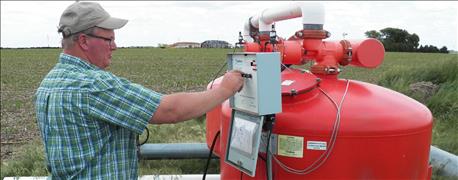June 8, 2015

After graduating from the University of Nebraska-Lincoln with an Agricultural Economics degree in 1981, Joel Bergman became the sole operator of the family farm, raising cattle, soybeans, and corn.
As Bergman continued to grow his business, he noticed the gravity pipeline irrigation system on his cropland wasn't running efficiently. There was an overuse of water, and as a result, crops weren't using fertilizer as effectively, resulting in non-uniform yields.

IRRIGATION UPGRADES: Joel Bergman worked with the USDA Natural Resources Conservation Service to install irrigation system improvements like this subsurface drip system.
Bergman wanted to save water, energy, labor, time, and money, and because his current gravity pipeline irrigation system was using an excess of water, wells and other machinery were getting worn out quickly. Bergman worked together with Curtis Scheele Water Quality Specialist at the USDA Natural Resources Conservation Service (NRCS) in Holdrege to plan an irrigation system that would improve water application and yield uniformity and reduce runoff, which ultimately improves water quality and the environment.
Upgrading to center pivots
With technical and financial help available from NRCS conservation programs, Bergman replaced his gravity pipeline irrigation system with center pivots.
"Center pivots are a much more efficient irrigation system," Scheele said. "They are about 90% efficient, compared to gravity pipelines, which are only about 50% efficient in getting water on the crop."
Bergman also installed a sub-surface drip irrigation system and a center pivot with help from NRCS. Using drip tape, underground emitters release water below the surface for the crops to use. The system runs at about 95% efficiency. Along with the NRCS, the Central Nebraska Public Power and Irrigation District (CNPPID) assisted in financing the project.
By making the switch from gravity to center pivot and sub-surface drip irrigation systems, Bergman was able to adopt no-till farming practices, and converted gravity irrigation to dryland on his pivot corners.
"I am very pleased with the project. It worked well. I am using a lot less water compared to the gravity pipeline, and yields have increased," Bergman said.
For more information on conservation programs and assistance available, contact your local NRCS office or visit the NRCS website.
Source: NRCS
You May Also Like




